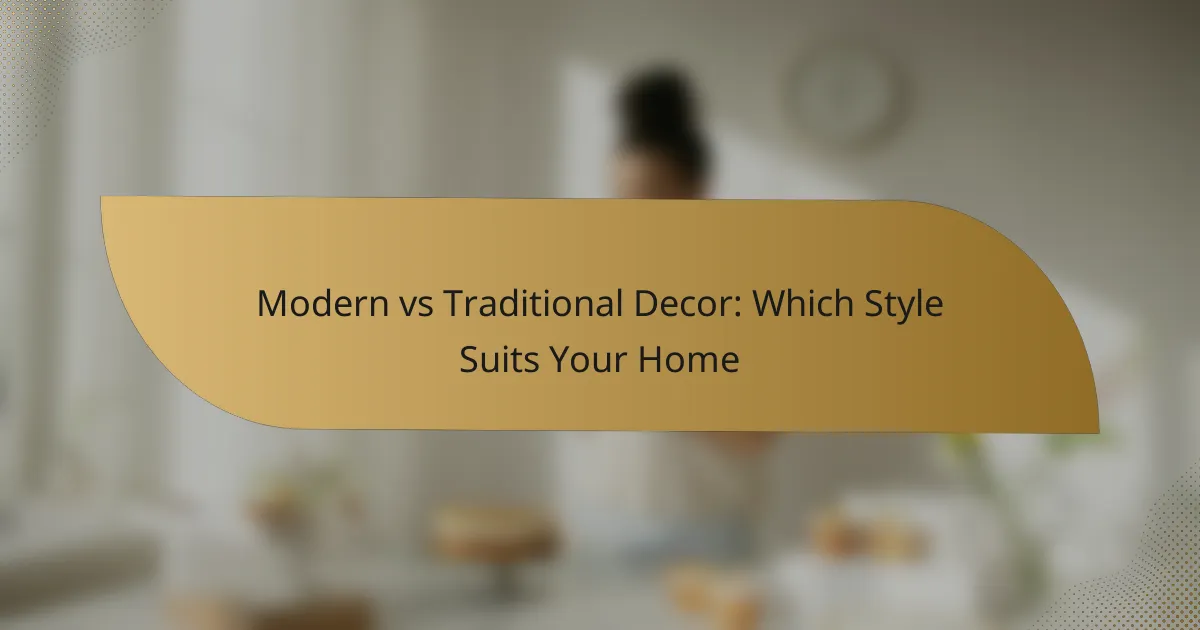When it comes to home decor, modern and traditional styles present distinct design philosophies that cater to different tastes and lifestyles. Modern decor focuses on simplicity and functionality, creating open and inviting spaces, while traditional decor embraces classic styles and intricate details. Understanding your personal style and the architectural features of your home can help you determine which approach best suits your living environment.
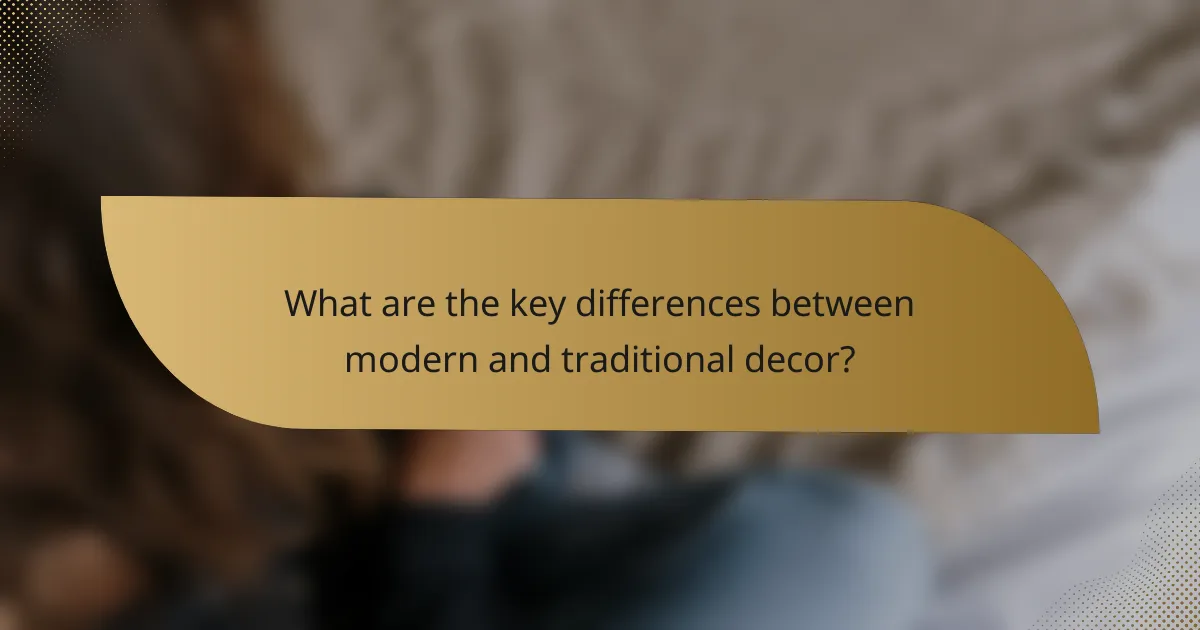
What are the key differences between modern and traditional decor?
Modern decor and traditional decor differ primarily in their design philosophies. Modern decor emphasizes simplicity and functionality, while traditional decor celebrates classic styles and intricate details.
Modern decor emphasizes minimalism and functionality
Modern decor is characterized by clean lines, open spaces, and a focus on practicality. This style often utilizes neutral color palettes, allowing for a calm and uncluttered environment. Furniture pieces are typically streamlined and may serve multiple purposes, which is ideal for smaller living spaces.
When choosing modern decor, consider incorporating materials like metal, glass, and natural wood. These elements not only enhance the aesthetic but also contribute to the overall functionality of the space. Avoid overcrowding rooms with excessive furniture or decor items to maintain that minimalist feel.
Traditional decor focuses on classic styles and ornate details
Traditional decor is rooted in historical design elements and often features rich colors, elaborate patterns, and decorative accents. This style embraces symmetry and balance, with furniture that showcases craftsmanship and intricate detailing. Common materials include dark woods, plush fabrics, and antique finishes.
To achieve a traditional look, consider using ornate light fixtures, patterned wallpaper, and classic artwork. Layering textures and incorporating heirloom pieces can enhance the warmth and character of the space. Be cautious not to overdo it; maintaining a cohesive theme is essential to avoid a cluttered appearance.
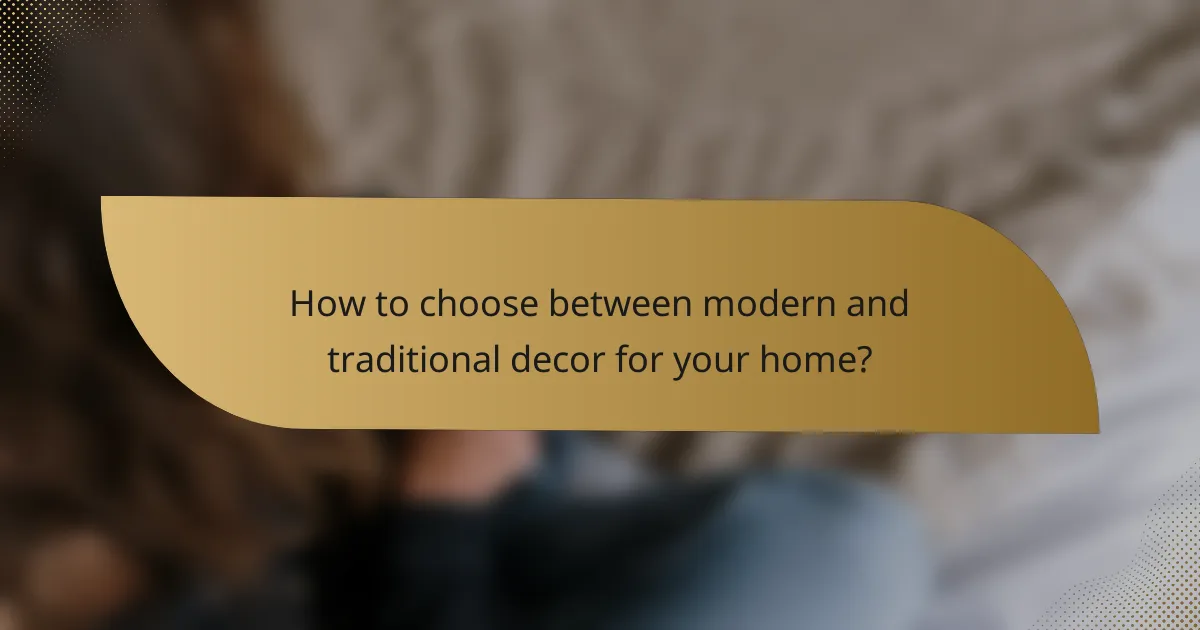
How to choose between modern and traditional decor for your home?
Choosing between modern and traditional decor involves assessing your personal style, the architectural features of your home, and how each style aligns with your lifestyle. Consider what resonates with you visually and functionally to create a harmonious living space.
Consider your personal style and preferences
Your personal style plays a crucial role in deciding between modern and traditional decor. Modern decor often features clean lines, minimalism, and a neutral color palette, while traditional decor embraces rich colors, ornate details, and classic furnishings. Reflect on what makes you feel comfortable and inspired in your space.
To help clarify your preferences, create a mood board with images that resonate with you. This can include furniture, color schemes, and textures that appeal to your aesthetic. Pay attention to how these elements make you feel and how they might fit into your home.
Evaluate the architectural features of your home
The architectural style of your home significantly influences the decor choice. Modern homes typically have open floor plans and large windows, making them ideal for contemporary furnishings and decor. In contrast, traditional homes often feature intricate moldings, fireplaces, and defined rooms, which can be complemented by classic furniture and decor elements.
Take note of key architectural features such as ceiling height, window styles, and built-in elements. For example, a home with high ceilings may benefit from tall bookshelves or large artwork, while a cozy, traditional space might be enhanced with layered textiles and antique pieces. Aligning your decor with these features can create a cohesive and inviting atmosphere.

What are the benefits of modern decor?
Modern decor offers a streamlined approach to home design, emphasizing simplicity and functionality. This style often results in spaces that feel open and inviting, making it ideal for contemporary living.
Offers a clean and uncluttered aesthetic
A key benefit of modern decor is its clean and uncluttered aesthetic, which promotes a sense of calm and order. By focusing on minimalism, this style reduces visual distractions, allowing for a more peaceful environment.
To achieve this look, consider using a limited color palette, opting for neutral tones with occasional bold accents. Furniture should be functional and streamlined, avoiding excessive ornamentation.
Incorporates innovative materials and technology
Modern decor often incorporates innovative materials and technology, enhancing both aesthetics and functionality. Materials like glass, metal, and concrete are commonly used, providing a sleek and contemporary feel.
Additionally, integrating smart home technology can elevate modern spaces. Consider features such as automated lighting, smart thermostats, and high-tech appliances to improve convenience and energy efficiency.

What are the benefits of traditional decor?
Traditional decor offers a sense of comfort and nostalgia, creating spaces that feel familiar and welcoming. It emphasizes classic design elements that can enhance the aesthetic appeal of your home while providing a timeless quality.
Creates a warm and inviting atmosphere
Traditional decor is characterized by rich colors, soft textures, and layered lighting, all of which contribute to a cozy environment. Elements like plush sofas, warm wood tones, and decorative textiles help to create a space where family and friends feel at ease.
To achieve this inviting atmosphere, consider using warm color palettes such as deep reds, earthy browns, and soft creams. Incorporating natural materials like wood and stone can further enhance the warmth of your home.
Showcases craftsmanship and historical significance
Traditional decor often highlights artisanal craftsmanship, showcasing furniture and decor items that reflect skilled workmanship. Pieces may include intricate carvings, handwoven textiles, and antique finishes, all of which tell a story and connect to cultural heritage.
When selecting traditional decor, look for items that have a history or unique craftsmanship. This could include vintage furniture, heirloom pieces, or locally made items that emphasize quality and tradition.
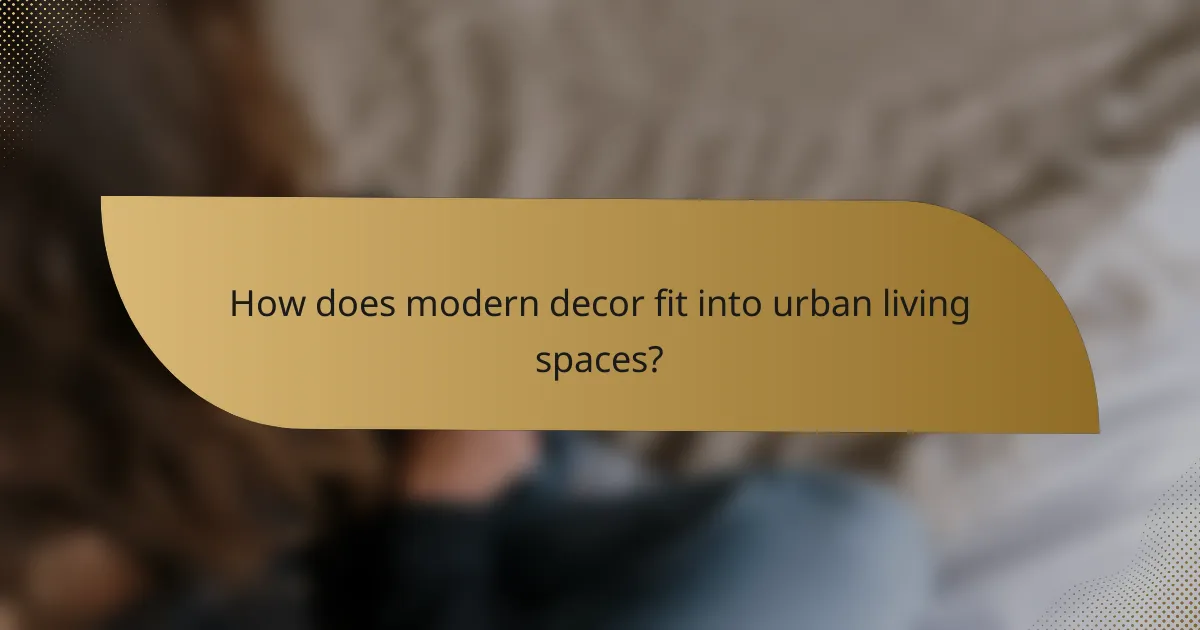
How does modern decor fit into urban living spaces?
Modern decor is designed to complement urban living spaces by emphasizing simplicity, functionality, and open layouts. This style often incorporates clean lines and minimalistic elements, making it ideal for smaller homes where maximizing space is essential.
Maximizes space efficiency in small apartments
Modern decor focuses on creating an open and airy feel, which is crucial in small apartments. By using light colors and reflective surfaces, these spaces can appear larger and more inviting. Consider using vertical storage solutions to keep the floor clear and maintain a sense of openness.
Incorporating large mirrors or glass elements can enhance the perception of space. Aim for furniture that doesn’t overwhelm the room; pieces that are sleek and low-profile work best in compact areas.
Utilizes multifunctional furniture
Multifunctional furniture is a hallmark of modern decor, particularly in urban settings where space is at a premium. Items like sofa beds, extendable dining tables, and storage ottomans serve multiple purposes, reducing clutter and maximizing utility.
When selecting multifunctional pieces, look for those that blend style with practicality. For example, a coffee table that doubles as a storage unit can help keep your living area organized while maintaining a contemporary look.
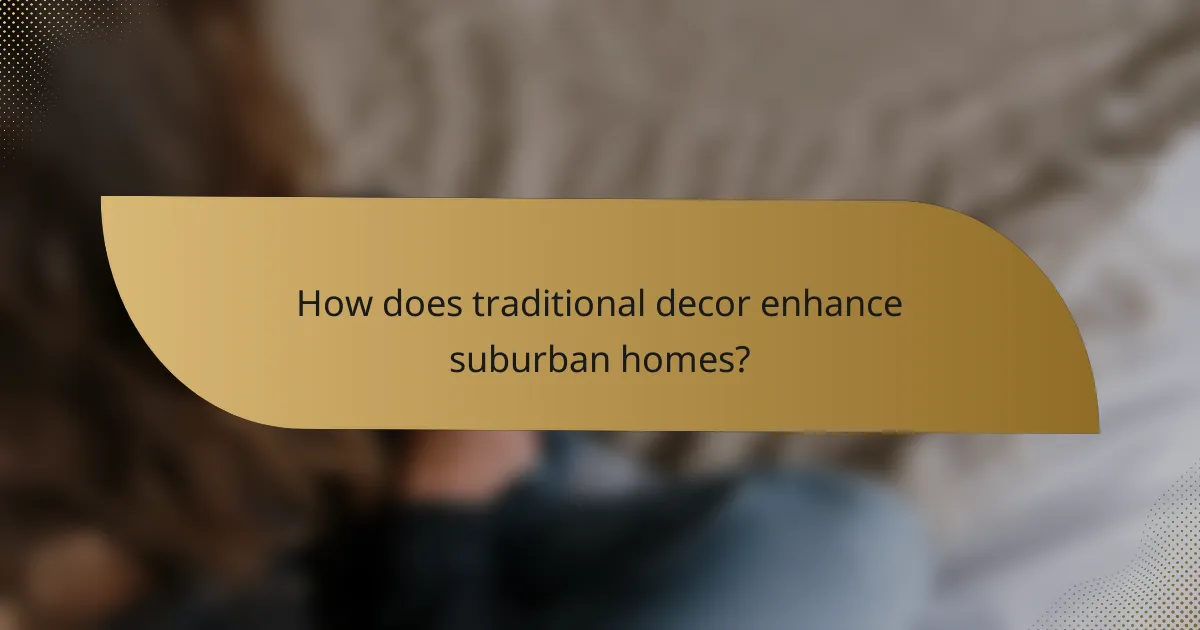
How does traditional decor enhance suburban homes?
Traditional decor enhances suburban homes by creating a warm, inviting atmosphere that reflects a sense of history and stability. This style often incorporates classic design elements, rich textures, and a cohesive color palette that can make a home feel more comfortable and lived-in.
Provides a sense of nostalgia and comfort
Traditional decor evokes nostalgia through its use of familiar patterns, classic furniture styles, and warm color schemes. Elements like floral wallpapers, antique furnishings, and cozy textiles can remind residents of their childhood homes, fostering a sense of comfort and belonging.
To achieve this nostalgic feel, consider incorporating vintage pieces or family photos into your decor. Soft lighting and layered textiles, such as quilts or heavy drapes, can further enhance the cozy atmosphere typical of traditional design.
Allows for personalized family heirloom displays
Traditional decor provides an excellent backdrop for displaying family heirlooms, such as antique furniture, artwork, or collectibles. These items not only serve as conversation starters but also tell a story about your family’s history and values.
When integrating heirlooms into your decor, choose a dedicated space like a display cabinet or a gallery wall. Ensure that these pieces are complemented by the overall color scheme and style of the room to maintain a cohesive look while showcasing your family’s unique heritage.

What are popular color palettes in modern decor?
Modern decor often features color palettes that emphasize simplicity and boldness. Popular choices include neutral tones paired with striking accent colors, as well as monochromatic schemes that create a unified aesthetic.
Neutral tones with bold accent colors
Neutral tones such as whites, grays, and beiges serve as a versatile backdrop in modern decor. These colors allow for the introduction of bold accent colors like navy blue, mustard yellow, or vibrant red, which can be used in furniture, artwork, or decorative elements.
When selecting accent colors, consider the overall mood you wish to create. For instance, warm tones can evoke coziness, while cool tones may lend a more tranquil feel. Aim for a balance that enhances the space without overwhelming it.
Monochromatic schemes for a cohesive look
Monochromatic color schemes involve using varying shades and tints of a single color, providing a harmonious and sophisticated appearance. This approach simplifies the design process and creates a seamless flow throughout the space.
To implement a monochromatic scheme effectively, choose a base color and incorporate different shades through paint, textiles, and accessories. For example, a range of blues can be used from deep navy to soft sky blue, ensuring visual interest while maintaining cohesion.
